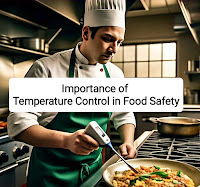Temperature control is crucial in food safety to prevent the growth of pathogenic microorganisms, such as bacteria, viruses, and parasites. Here are some reasons why temperature control is important:
Prevents Bacterial Growth
1. Prevents bacterial growth: Bacteria like Salmonella, E. coli, and Campylobacter grow rapidly in the "danger zone" of 40°F to 140°F (4°C to 60°C). Temperature control helps prevent bacterial growth.
2. Reduces risk of foodborne illness: By controlling temperature, the risk of foodborne illness is significantly reduced.
Maintains Food Quality
1. Maintains food quality: Temperature control helps maintain the quality and texture of food, preventing spoilage and extending shelf life.
2. Prevents enzymatic reactions: Temperature control prevents enzymatic reactions that can cause food to spoil or become unpalatable.
Regulatory Compliance
1. Meets regulatory requirements: Temperature control is a critical aspect of food safety regulations, such as HACCP (Hazard Analysis and Critical Control Points).
2. Avoids costly fines and penalties: Failure to maintain proper temperature control can result in costly fines, penalties, and damage to a company's reputation.
Best Practices
1. Use thermometers: Use thermometers to monitor temperature regularly.
2. Store food properly: Store food at the correct temperature, using refrigerators, freezers, or hot holding units.
3. Cook food to a safe temperature: Cook food to a safe internal temperature to prevent bacterial growth.
4. Reheat food safely: Reheat food to a minimum of 165°F (74°C) to prevent bacterial growth.
By controlling temperature, food businesses can ensure the safety and quality of their products, meet regulatory requirements, and maintain customer trust.











0 comments:
Post a Comment